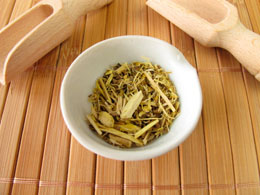The roots of the Oregon grape plant are highly valued for their medicinal properties. Go through this article for a brief overview about the herb and its uses.

The Oregon grape is a shrub, that is not at all related to grapes; but it produces clusters of purple-colored berries, that resemble bunches of grapes. The Oregon grape plant belongs to the genus
Mahonia, in the family
Berberidaceae. It is different from the creeping and dwarf types of Oregon grape. While the fruits are used for culinary purposes in some regions, the roots are highly valued for their medicinal properties.
Oregon Grape Plant - Features
The Oregon grape plant (
Mahonia aquifolium) is a shrub with green leathery leaves. They have thick stems and yellow flowers, that emerge in clusters during spring. The Oregon grape is the state flower of Oregon. As mentioned above, these plants produce purple berries that are used by some people, for preparing jams, jellies, and wine. These plants are also grown for ornamental purposes. A yellow dye is prepared from their stems and roots.
The Oregon grape, that is native to the North American west coast, is used for medicinal purposes too. It is said that the Plateau Indians (indigenous people of the Plateau of Western Canada and the United States) have been using this herb for a very long time. Oregon grape root has been used in different parts of Europe, for therapeutic purposes, throughout the centuries. It is also contended that this berry has been brought to America, by the English settlers.
Benefits of Oregon Grape Root
Oregon root is bright yellow in color with a bitter taste. It is said to have antimicrobial, antiseptic, anti-inflammatory, and antibacterial properties. This herb is claimed to possess anti-cancer properties too. Oregon grape root contains high levels of alkaloid berberine, which is also a constituent of some other healing herbs, like goldenseal. Studies show that berberine has both fungicidal and antibacterial properties, and can be effective against infections caused by
Giardia lamblia, Trichomonas vaginalis and
Entamoeba histolytica. Some herbalists recommend use of Oregon root along with antibiotics, or a replacement for the same.
One of the most important benefits of Oregon grape root is its use in treating digestive problems. You might have heard about its use for relieving indigestion and constipation. It is classified as a natural laxative, and has been used as a constipation remedy. Apart from that, this herb is said to be effective in stimulating the flow of bile, thereby preventing conditions, like diverticulosis, hemorrhoids, gallbladder disease, certain types of IBS, and constipation. It is said that Oregon grape root is useful for purifying blood and detoxifying the liver. The herb is also used for treating conditions, like liver cirrhosis. It is used for treating skin disorders, like psoriasis, eczema, and herpes.
Oregon grape root is usually taken in the form of herbal tea, pills, or tincture. Even creams and ointments with this herb, are available for treating certain skin conditions. While topical application of Oregon cream is considered safe, there is insufficient information about ingestion of this herb. So, it is advisable to consult a qualified herbal practitioner, and use this herb according to his instructions.
In some cases, topical application may cause side effects, like itching and burning sensation. Though rare, allergic reactions may also develop. Avoid long-term use and over dosage. This herb is also not recommended for pregnant and nursing women, kids, and those with severe diarrhea. Even those with heart disease, high blood pressure, and glaucoma, must avoid use of Oregon grape root.
Disclaimer:
This article is for informational purposes only, and should not be used as a replacement for expert medical advice.






 The Oregon grape is a shrub, that is not at all related to grapes; but it produces clusters of purple-colored berries, that resemble bunches of grapes. The Oregon grape plant belongs to the genus Mahonia, in the family Berberidaceae. It is different from the creeping and dwarf types of Oregon grape. While the fruits are used for culinary purposes in some regions, the roots are highly valued for their medicinal properties.
The Oregon grape is a shrub, that is not at all related to grapes; but it produces clusters of purple-colored berries, that resemble bunches of grapes. The Oregon grape plant belongs to the genus Mahonia, in the family Berberidaceae. It is different from the creeping and dwarf types of Oregon grape. While the fruits are used for culinary purposes in some regions, the roots are highly valued for their medicinal properties.